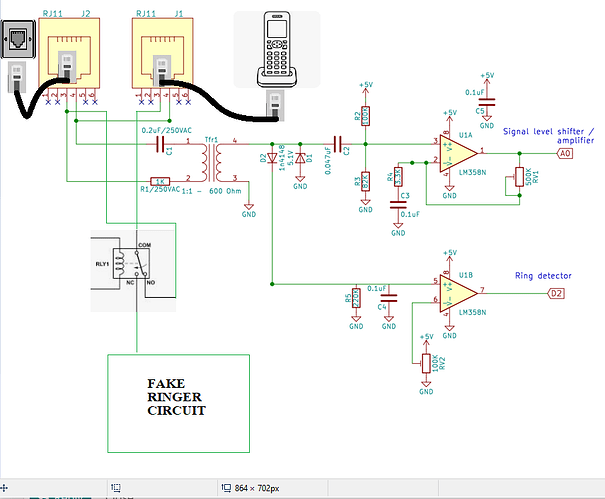To couple the 20Hz 90VAC ring signal to circuitry to detect it. You will use a capacitor that has a low impedance at 20 Hz and a voltage rating high enough to tolerate the peak AC value, say 250V for a common value.
What is a capacitor with low impedance?
Can you please draw me a capacitor/ optocoupler phone line to Arduino diagram
Okay, I'm out of here. This is pointless.
OK. You could emulate the functionality of a private telephone exchange (PBX) and do something similar to what you have described once you determine that the incoming call is not one of your special "data" calls. Good luck with building all that.
A simpler approach, which could work if all these "data" calls come from a dedicated number is as follows. You could read the incoming caller id (it comes between the first and second ring burst) and if it is that of the dedicated number then answer it automatically and process it, otherwise ignore it and let it ring as usual. There are lots of arduino projects around for interpreting telephone system caller ids. Some even handle spam calls.
You are right this would make it simple, but my problem with that approach is that if the person is trying to make a real call home how do the people at home know that there's a call coming in?
Then it is not a dedicated number, that is it is not a number which could be recognised as being exclusively for sending this special data to your landlines number. That approach works only with a dedicated number.
Some phone services allow you to suppress the outgoing caller id. For a "real call" this could be temporarily suppressed so the call would get through without being answered automatically.
Very good sentiment.
So dont forget to contact your regulator or telco company and ask for the rules they require you to follow before attaching random equipment to the telephone network and wires.
Apparently they have concerns that some people without a full understanding or experience of the issues will attach stuff to the wires that could harm other equipment or people.
Might be useful when using the MT8870 DMTF decoder
Thanks @robtillaart the MT8870 looks promising. Have you used it with landline? does it tolerate 7v / 50v ?
Here you can find lots of even simple circuits for interfacing to a (pots) telephone system, for example for audio recording etc. (all subject to any possible necessary regulatory approval ): Telephone interfacing circuits
Wrote that library on request IIRC,
From my head, power supply for the chip is 5V, expect it won't tolerate 7V for long, use an 7805 to limit that.
The 50V (or more) from landline, don't know check datasheet for the details
HI @6v6gt I saw your beautiful post about Telephone Caller ID Dev Kit well done!!
what do you think about adding a relay between the phone line and the house phone.
1--> disconnect the house phone from the line the second a ring is detected
2--> if valid code than stay at the dev kit and use it as smart home hub
3--> if invalid code or no code is entered
4--> put a fake calling signal on the house phone
5--> sense for the home phone pick up hook
6--> if sensed reconnect to phone line
step 4 shouldn't be to hard to create have you got a easy diagram for this?
but step 5 any idea how to sense this action?
and by step 6 would the phone stay connected?
see your modified diagram for more clarification:
That circuit was designed to detect the AFSK encoded callerID bitstream which is delivered between the first and second ring burst. There I also used a software detection of the ring tone, however, I have a newer design (unpublished but actually in use) which provides a more reliable ring burst detection based on an optocoupler circuit which I am attaching.
Having said that, although I believe you could possibly achieve your aims, I would not myself like to make such an invasive change to the architecture of a domestic phone installation. Apart from the technical considerations, you have to consider any rules of your telephone service provider. Also, if you do seize a call to check if it is a special "data" call, you have all the complexity of keeping it on hold, ringing other phones, injecting a signal into the voice path so the caller hears some sort of ring tone, detecting any handset going off hook, etc. etc. so you are getting close to a PBX type functionality as I have already said. Here, I can't help with any detail and it is beyond may area of expertise for public phone systems.
However, if you do want to pursue this, my suggestion is that you start your experiments with simply transmitting tones over the phone line to ensure that you can receive and decode these with good fidelity. You can use DTMF as you originally planned or AFSK.
If you get that far, then you can proceed, offline, to start with of getting the other phones in the house to ring and conduct experiments to detect if these are answered.
For ringing phones and detecting pickup etc., I have a couple of published projects in the forum's "showcase" , one to ring vintage telephone bells and one to use two old dial telephones as an intercom. The latter is quite complicated because it is optimised for battery operation and can be significantly simplified if power consumption is not a problem. Both are completely isolated from any telephone network.
EDIT
Maybe also look at Asterisk, an open source PBX system which runs on Linux and even a Raspberry Pi.
This topic was automatically closed 180 days after the last reply. New replies are no longer allowed.

